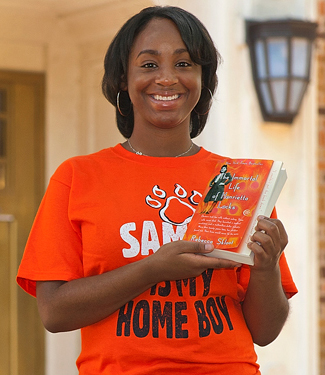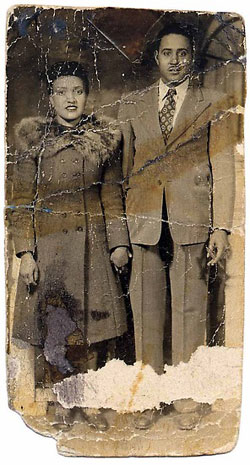Orientation Leader Discusses 2012 Common Reader Selection
June 7, 2012
SHSU Media Contact: Jennifer Gauntt
 |
| This year's New Student Orientation leaders read the 2012 Common Reader Program selection, The Immortal Life of Henrietta Lacks. They will introduce new students to the book during orientation sessions. |
Jasmine Moultrie is a junior English major from Houston. As a first-year orientation leader for the summer New Student Orientation program, Moultrie was asked to read and discuss this year's Common Reader Program selection, "The Immortal Life of Henrietta Lacks." In the following narrative, Moultrie shares her thoughts on the book, how the story defied her initial expectations, and why students should participate in this year's Common Reader Program.
 As an English major and aspiring teacher, I’m used to people of various majors asking me to review and edit their papers, giving commentary, and even suggesting better words or sentences to use. But when asked if I would be interested in writing an article for the Common Reader, I could barely keep my seat. I’ve become accustomed to writing countless essays and research papers, but I’ve never written an actual article before, especially about a book. Not only was the offer a great opportunity, but it was also a challenge I enthusiastically accepted. The next day, I began reading and taking notes on Rebecca Skloot’s The Immortal Life of Henrietta Lacks.
As an English major and aspiring teacher, I’m used to people of various majors asking me to review and edit their papers, giving commentary, and even suggesting better words or sentences to use. But when asked if I would be interested in writing an article for the Common Reader, I could barely keep my seat. I’ve become accustomed to writing countless essays and research papers, but I’ve never written an actual article before, especially about a book. Not only was the offer a great opportunity, but it was also a challenge I enthusiastically accepted. The next day, I began reading and taking notes on Rebecca Skloot’s The Immortal Life of Henrietta Lacks.
I was introduced to the book about a week earlier in one of my Orientation Team meetings. And when we were told it was a book about cells, I was a little doubtful. I sat in an upstairs Old Main Market conference room thinking, “It’s about cells? The freshman class will never read this.” I couldn’t have been further from wrong. My initial skepticism melted even before I even read the first page of book’s prologue. Chapter after chapter, the book became addictive as the author gave life to the woman behind the cells.
The fiery orange and red cover of The Immortal Life of Henrietta Lacks could catch any reader’s eye right off the shelf of a bookstore. It features a picture of Henrietta and highlights the first two letters of her first and last name, HeLa, the name given to her immortal cells. The book is divided into three parts and comes fully equipped with an afterword, timeline, list of characters, and a small section that keeps the reader up to date on how some of the characters are currently doing.
The author first captures the reader with a stamp of authenticity, promising her readers a true story that has not been altered for entertainment or convenience. While scientists and researchers fought to conceal her real full name, the author presents Henrietta, her past and her cells’ future in a manner that is both informational and captivatingly fascinating. The chapters alternate between Henrietta and her family’s histories and Skloot’s journey writing the narrative, an intertwined braid of narration and fact. Cover to cover, Skloot incorporates brilliant comparisons and imaginative descriptions that are artistically vivid, yet easily accessed and understood, especially when explaining scientific terms for the reader’s comprehension. Henrietta and her family’s historical accounts are laced with stories of child abuse, incestuous molestation, neglect, and injustice. The book also explores medical research’s progress towards human rights and the ethics of patient consent, both fueled by the theft and manipulation of Henrietta’s cells.
 |
| Henrietta Lacks, pictured above with her husband Day, died in 1951 at the age of 31, but cells from her cancerous cervical tumor still live today. The research conducted on them have led to innumerous medical breakthroughs. |
HeLa’s accomplishments and contributions to science are almost endless. Long after Henrietta’s death, her cells kept scientists busy with extensive research and discoveries as they explored HeLa’s boundaries and capacities. The wide scope of achievements includes going on the first space missions, developing chemotherapy treatments for cancer patients, cloning, and even helping doctors to properly distinguish and correctly diagnose chromosomal disorders. Henrietta’s cells were also the driving force behind the world’s first cell distribution centers, companies that sell and deliver cells for scientific research.
While Henrietta’s immortal cells were used for incredible medical advances, they were also used in gray areas of deceit and exploitation. From the very beginning of their history, the cells were taken without permission and after Henrietta’s death, none of her family knew her cells were being used for scientific study. As HeLa became more popular, they became the subject of peculiar experiments, one in particular involved a human and animal cellular hybrid. Later on in their use, the cells even became a source of panic and havoc for scientists, calling for years of research to be reviewed and, in some cases, unsanctioned.
If the ups and downs of Henrietta’s story or the history of her cells doesn’t capture our newest Bearkats, the characters will definitely leave a lasting impression on the readers. Perhaps the most colorful character in the book is Henrietta’s daughter, Deborah, with whom I felt most connected; her experience learning about her mother and the cells are a heart wrenching tale of excitement, misplaced trust, and health complications. The insight we are given into the thoughts and fears of Deborah allows us to share the same feelings she experiences throughout her personal adventure. The resulting relationship created between character and reader draws us closer and envelopes us into this enchanting book.
Not only is The Immortal Life of Henrietta Lacks a great story, but incoming freshman students will get to discuss the book with their peers in classes like University 1301, art, English, and even political science. Also, students will also have the opportunity to participate in an essay contest, writing and entering a short personal narrative about their experience reading the book. The winner will be awarded a $500 scholarship and recognition at an on-campus book forum, where Henrietta’s son will be speaking.
After reading the book in its entirety, there is no longer any doubt that our incoming Bearkats will absolutely love The Immortal Life of Henrietta Lacks. After I finished reading it one late night I raved about it to my fellow Orientation Team members, saying it was one of the hardest books to put down that I have ever read. It is unlike anything I’ve ever read and its originality is just one of its best assets. Rebecca Skloot’s narration is infectious and her treatment of Henrietta’s family is endearing. The Immortal Life of Henrietta Lacks is honestly one of the best books I have ever read, and I’m sure the freshman class will enjoy it as much as I did! Read to Succeed Kats!
For more information on "The Immortal Life of Henrietta Lacks" or the First Year Experience office's Bearkats Read to Succeed program events, visit http://www.shsu.edu/~fye_www/read.html.
- END -
This page maintained by SHSU's Communications Office
Associate Director: Julia May
Manager: Jennifer Gauntt
Located in the 115 Administration Building
Telephone: 936.294.1836; Fax: 936.294.1834
Please send comments, corrections, news tips to Today@Sam.edu.

 SamWeb
SamWeb My Sam
My Sam E-mail
E-mail

